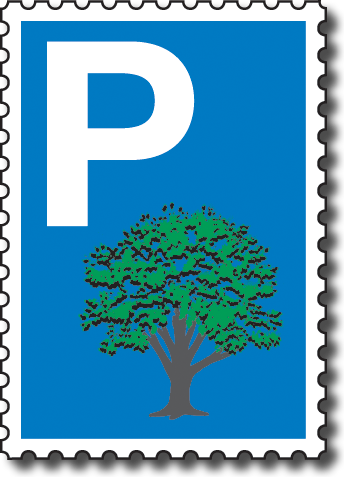Historical Photos
1792: The Perkins House
The Perkins House was located on Pearl Street (formerly Hutchinson Street) in the area of Boston referred to during the 18th Century as the “Old South End.” The Old South End encompassed the area south of Milk Street between Washington Street and the waterfront, including the area that is presently Post Office Square. At the time, Pearl Street was lined with large houses and their attendant stables and gardens. The brothers James and Thomas Handasyd Perkins were both China trade merchants who lived in side by side mansions at 13 and 17 Pearl Street, currently 185 Franklin Street and the Garage at Post Office Square. Other notable Boston families living on Pearl Street included Josiah Quincy, who was mayor of Boston and the developer of Quincy Market, as well as the Pratts, who had the largest garden in the neighborhood at the corner of Milk and Pearl Street. 13 Pearl Street was donated to and housed the Boston Athenaeum from 1822 to 1849. 17 Pearl Street was also donated and renamed The Perkins Institution for the Blind. By the mid 1800’s few of the elegant mansions on Pearl Street remained and those that did had been converted to commercial use – all were destroyed in 1872 in the Great Fire of Boston.
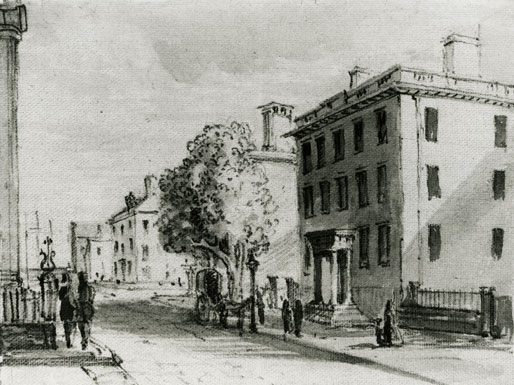
Photograph Courtesy of Boston Athenaeum
1872: The Great Fire of Boston
The Great Fire of Boston started at 7:24 PM on November 9, 1872 in a four-story granite building on Summer Street. It spread for two days throughout the business district, reaching Washington Street to the west, Water Street to the north, and the waterfront to the east. At the height of the fire, ships ninety miles off the coast of Maine reported seeing the bright glow on the horizon. By the time the devastating flames were fully extinguished on Monday, November 11th, 776 buildings were destroyed and damage estimates totaled more than $12 million. The spread of the fire was aided by the poorly planned narrow streets and closely built commercial buildings, which were often constructed with wooden roofs and were packed with dry good storage in attics and basements. Efforts to fight the fire proved difficult as water mains in the commercial district had been put in at a time when the area was still residential, and water pressure was not sufficient to reach the top floors of the burning buildings. Adding to the fire department’s difficulties, a contagious epidemic, the horse flu epizootic, immobilized the fire department’s horses leaving all fire fighting apparatus to be pulled by manpower alone. This caused a delay in the fire department’s response time, and may have allowed the initial fire on Summer Street to reach the roof of the building, at which point it became quickly out of control. The fire chief at the time of the fire, Chief John S. Damrell, was pressured by the mayor, who was up for re-election, and a council of concerned citizens, to use explosives to destroy buildings that lay in the path of the spreading fire. This strategy to fight the fire failed – many buildings did not fall after the explosions that were meant to demolish them, and the fires that began as a result of the explosions may have allowed the spread of the fire beyond Federal and Milk Streets. Extinguishing the fire took the resources of more than 2163 men and 66 engines. Fire departments as far away as Connecticut responded to Chief Damrell’s signals for help.
After the fire of 1872, Chief John S. Damrell pushed for tighter building and city planning codes, eventually leaving the fire department and working as the Building Commissioner for the City of Boston. He became instrumental in developing a national association of fire chiefs, which worked to push the new fire codes through state legislatures nationwide.
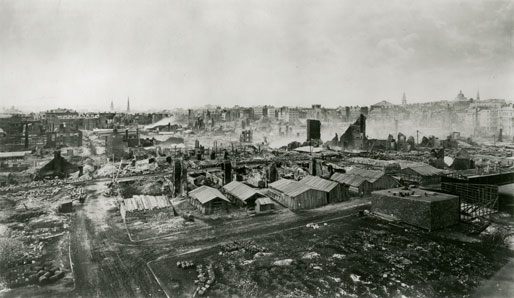
Photograph Courtesy of Bostonian Society/Old State House:
Panorama of the Great Fire, 1872, VW001-004274
Boston Streets Photo. Collection, ca 1855-1999
1888: The United States Post Office Building
The United States Post Office Building, which was located on Congress Street between Milk and Water Streets, was still under construction at the time that the Great Fire of 1872 destroyed most of the surrounding commercial district. The building became a last line of defense during the Great Fire, and its massive walls are sometimes credited for halting the fire’s northward progress. During reconstruction of the commercial district, fire codes were enforced and tighter city planning guidelines instituted, resulting in widened streets, including Congress and Pearl Streets, and the extension of Franklin Street past Congress to Broad Street. The converging, widened streets left a triangular clearance of land in front of the Post Office, which became known as Post Office Square, and shaped the block that is currently Norman B. Leventhal Park.
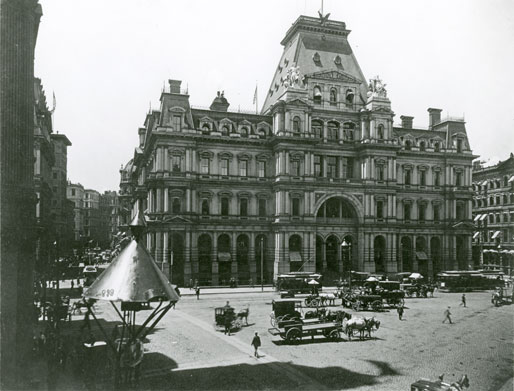
Photograph Courtesy of Bostonian Society/Old State House:
United States Post Office and Treasury Building ca. 1888, VW0056-004210
Illustrated Boston Lantern Slide Collection, 1888
1902: The New England Mutual Life Building
The New England Mutual Life Building was designed by Nathaniel Bradlee and built during the reconstruction of the commercial district after the Great Fire of 1872. It was located on the current site of the Norman B. Leventhal Park, on the block that was formed when Franklin Street was extended past Congress Street to Broad Street, and Pearl and Congress Streets were widened to comply with new city planning and fire codes. The building’s main entrance faced Post Office Square, a small triangular open space, named for the nearby Post Office that had survived the fire. The ornately designed building was a Boston landmark until it was demolished in 1946, after which the space was left as an open, cobblestone plaza that remained undeveloped for almost a decade.
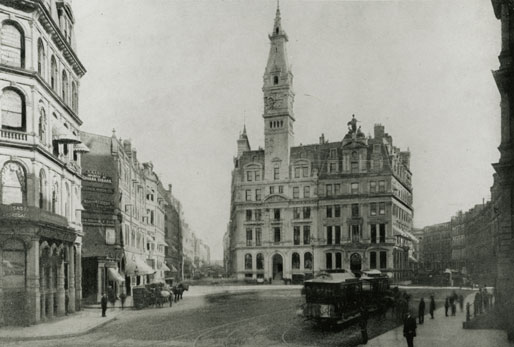
Photograph Courtesy of Bostonian Society/Old State House:
View of Post Office Square, looking south, ca 1902, neg. 6019
1954: Parking Garage Unit 3
Parking Garage Unit 3 was a four-story, 950 car garage built in 1954 on city-owned land. The land was leased for 40 years to garage and taxi magnate, Frank Sawyer, for the purpose of enticing business back into the downtown retail area. The garage was known as an eyesore and a blight on the community – the property was unmaintained and trash-strewn, and the entrance regularly caused major traffic jams on Congress Street.
In the late 1970s, Norman B. Leventhal, head of the Boston development firm The Beacon Companies, obtained and redeveloped the property abutting the garage on Pearl Street. With the opening of Hotel Meridien (currently the Langham) at 250 Franklin Street in 1981, Leventhal formed a resolution to rid the financial district of its unsightly blemish. By 1983, Leventhal formed Friends of Post Office Square, Inc. with the vision of creating a public green space that would be privately maintained and funded by an underground garage. After a 4-year legal and political battle between the Friends and Frank Sawyer, the Friends of Post Office Square was finally able to purchase the garage in 1987, and in 1988 demolition began.
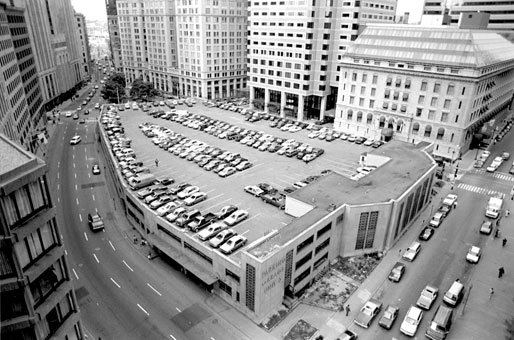
Photograph Courtesy of Bill Horsman
- View historical maps from the collections of the Norman B. Leventhal Map Center at the Boston Public Library

